|
Additional Lessons |
 About These
Lessons About These
Lessons
The following classroom lessons are great for students
who want additional listening and reading practice. |
-
Travel America -
Beginner
Level. Do you love America and American
English? Learn before you travel. Facts and other
cool stuff about your favorite U.S. state. Great
English reading practice.
|
 Travel
America - North Carolina Travel
America - North Carolina
(Beginner -
Reading)
Learn some interesting facts and read interesting
stories about North Carolina. |
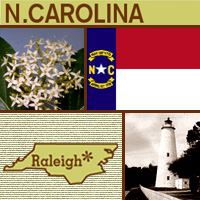 North
Carolina North
Carolina
The first European settlement in North Carolina is
the famous Lost Colony of Roanoke Island that
vanished sometime after 1587. North Carolina is the
northern portion of the original 1629 land grant
made by England's King Charles I, which was named in
his honor (Carolus is Latin for Charles). North
Carolina joined the Union in 1789 and is the 12th of
the original 13 states. Today, North Carolina is a
growing research center and banking state. The
capital of the "Tar Heel State" is Raleigh, and the
dogwood blossom is the state flower. |
North Carolina
State Flag
A state flag for North Carolina was not established
until 1861 when the constitutional convention passed the
ordinance of secession which read:
"(The flag) ... shall consist of a red field with a white
star in the centre, and with the inscription, above the
star, in a semi-circular form, of "May 20th, 1775," and
below the star, in a semi-circular form, of "May 20th,
1861." That there shall be two bars of equal width, and the
length of the field shall be equal to the bar, the width of
the field being equal to both bars: the first bar shall be
blue, and second shall be white: and the length of the flag
shall be one-third more than its width."
This flag was used by North Carolina troops during the Civil
War and existed until 1885 when a new design was adopted:
SEC. 1. That the flag of North Carolina shall consist of a
blue union, containing in the centre thereof a white star
with the letter N in gilt on the left and the letter C in
gilt on the right of said star, the circle containing the
same to be one-third the width of the union.
SEC. 2. That the fly of the flag shall consist of two
equally proportioned bars; the upper bar to be red, the
lower bar to be white; that the length of the bars
horizontally shall be equal to the perpendicular length of
the union, and the total length of the flag shall be
one-third more than its width.
SEC. 3. That above the star in the centre of the union there
shall be a gilt scroll in semi-circular form, containing in
black letters this inscription "May 20th, 1775," and that
below the star there shall be similar scroll containing in
black letters the inscription: "April 12th, 1776."
The date May 20, 1775 refers to the Mecklenburg Declaration
of Independence (though historians debate the authenticity
of this document and so many North Carolinians question the
legitimacy of having this date on the state flag).
The May 20th, 1861 date commemorated North Carolina's
secession from the Union. This second date was replaced in
1885 with "April 12th, 1776." to commemorate the Halifax
Resolves, a document that places North Carolina in the front
rank among those that demanded unconditional freedom and
absolute independence from any foreign power (considered a
great landmarks in the annals of North Carolina history).
This flag remained unchanged for over 100 years until 1991
when minor changes were made (commas were removed from the
dates and the total length of the flag was changed to
"one-half more than the width." |
|
Source:
State Symbols USA |
|
|
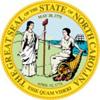 North Carolina
State Facts North Carolina
State Facts
Picture: state seal of North Carolina |
|
State Capital |
Raleigh |
|
Nickname |
Tar Heel State / Old North State |
|
Motto |
Esse Quam Videri (To Be Rather Than To Seem) |
|
Statehood |
November 21, 1789 (12th) |
|
Origin of Name |
Taken from "Carolus," the Latin word for Charles and
named after England's King Charles I. |
|
Largest Cities |
Charlotte, Raleigh, Greensboro, Winston-Salem,
Durham |
|
Border States |
Georgia, South Carolina, Tennessee, Virginia |
|
Area |
48,718 sq. mi., 29th largest |
|
State Bird |
Cardinal |
|
State Flower |
American Dogwood (cornus florida) |
|
State Tree |
Longleaf Pine (pinus palustris) |
|
State Song |
The Old North State |
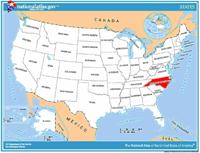 Travel and tourism site
for North Carolina - This state travel and territorial
tourism site provides ideas for your vacations, meetings, and more. Travel and tourism site
for North Carolina - This state travel and territorial
tourism site provides ideas for your vacations, meetings, and more. |
|
|
North Carolina Stories |
|
|
Kitty Hawk, North Carolina
The Wright brothers were from Ohio, but they achieved most of their
successes in North Carolina. Do you know why they decided to do
their flying experiments there?
To find a better location for their pioneering aeronautical
(aircraft) experiments than their home in Dayton, Ohio, Orville and
Wilbur Wright consulted the U.S. Weather Bureau. The brothers found
that the town of Kitty Hawk, North Carolina, offered the sand dunes
and high winds that they hoped would help them in their attempts at
powered flight.
The Wrights spent months in North Carolina working toward their
goal. On December 17, 1903, they finally succeeded. Orville flew the
powered glider first, then Wilbur, then each once more. The brothers
had achieved the first powered, controlled, sustained flight of a
heavier-than-air machine. |
|
|
Unto These Hills
Often the best material for drama comes from real life. Each summer,
a play called Unto These Hills is performed in Cherokee, North
Carolina. It tells the history of the Cherokee Indians, including
the journey they took from their homes in Georgia to Oklahoma. This
journey is called the "Trail of Tears." Do you know why?
The Cherokee Indians lived in the southeastern United States. By the
late 1700s, white settlers began taking their land. In 1838 and
1839, U.S. troops forced 15,000 Cherokees to march from their homes
in Georgia to northeastern Oklahoma. About 4,000 Cherokees died from
starvation, cold weather, illness, and exhaustion from the long
116-day journey. That march is known as the "Trail of Tears." Not
all Cherokees left Georgia, however. A few hundred managed to escape
to the mountains, and their descendants now live in North Carolina.
Today, some of those Cherokee Indian descendants take part in the
play, Unto These Hills.
In this photograph, players are performing the Cherokee Eagle Dance,
which was originally a victory celebration. The Cherokees respect
and honor the eagle because of its strength. |
|
|
Ole Time Fiddler's and Bluegrass Festival
Though they may not know it, the kids playing the fiddle in the
photo are helping to preserve a tradition that began over 75 years
ago.
Every year, families and musicians get together to play and listen
at the Ole Time Fiddler's and Bluegrass Festival in North Carolina.
They play in bluegrass bands and individual competitions. Musicians
of all ages, even little children, may participate. Some of the
tunes played are more than 100 years old.
The festival began in 1924 in the small rural community of Union
Grove, Iredell County, North Carolina. Local teacher and musician
H.P. Van Hoy and his wife, Ada, started the festival in order to
raise money for school supplies. Back then it was called Van Hoy's
Fiddlers Competition and half the money raised went to schools and
the other half went to prizes for the competitors. It was so popular
and grew so big that it had to move locations and it changed names.
Today, the festival helps preserve the tradition of old time and
bluegrass music. Old time music is traditional or folk music played
in rural areas of the South. Old time musicians usually play
stringed instruments, such as the fiddle or banjo. Bluegrass grew
out of old time music in the mid-20th century and is a kind of
country music. |
|
|
African American Cultural Complex
Did you see the movie "Amistad"?
The movie was based on a real life event. In 1839, a ship called La
Amistad set sail from Havana, Cuba. It carried 53 Africans who had
been kidnapped in West Africa. The ship was supposed to take them to
plantations where they would work as slaves. But during the trip,
the Africans rebelled and took over the ship. Their leader was a man
named Cinque. The Africans told the ship crew to sail them back to
Africa, but, at night, the sailors turned the opposite way. Finally,
the ship ended up in New York, and the Africans were put in jail. An
American attorney named Roger Sherman Baldwin, with the help of
former President John Quincy Adams, defended the Africans in a case
before the U.S. Supreme Court. The court ruled that the Africans
should be freed.
The story of Amistad was found in 1993 by Dr. E.B. Palmer, an
educator who was doing research on African American history. He and
his wife, Juanita, were founders of a museum and educational center
for African American history -- the African American Cultural
Complex in Raleigh, North Carolina. They thought the story of
Amistad was an important part of African American and North Carolina
history. So they decided to have a playwright write a play based on
it. As a result, in 1999, the play The Amistad Saga: Reflections was
performed at the African American Cultural Complex. |
|
|
Lexington Barbecue Festival
Did you know that Lexington, North Carolina, is known as the
Barbecue Capital of the World? In Lexington, October was officially
declared "Barbecue Month" and the cycling event, the Parade of Pigs
(also called the Tour de Pig), in the photo is part of the
month-long celebration known as Barbecue Festival.
If you didn't already guess, Lexington is famous for its barbecue.
The city's first barbecue restaurant opened in 1919. Lexington
barbecue is pork shoulder basted with "dip," a mixture of water,
vinegar, salt, and pepper. It is cooked slowly over hickory wood
until it is "fall apart tender." One pound of pork takes about an
hour to cook. Today there are over 20 barbecue restaurants in
Lexington.
In the 1994 Barbecue Festival, 11,000 pounds of barbecue were served
to more than 100,000 people. But eating isn't the only thing people
do at the festival. In addition to the Tour de Pig, there is Piglet
Land, where there are rides and games for kids. |
|
|
The Lost Colony
Do you know the story of the lost colony of Roanoke Island?
The legend of Roanoke Island has been passed down from generation to
generation since 1590 when a group of 120 English settlers
mysteriously vanished.
In the late 1500s, the English made their first attempts to settle
in North America on Roanoke Island, which is off the coast of North
Carolina. These first settlers ended up returning to England because
of a shortage of food and Indian attacks.
In 1587, a second colony was founded on Roanoke. It was then that
Virginia Dare, the first baby born to English parents in North
America, was born. John White, the leader of the colony, went to
England to get more supplies. When he returned in 1590, the
settlement was deserted. All the settlers had mysteriously
disappeared. The only clue he found was the word "Croatoan" carved
in a tree. To this day no one knows what happened to them. It's
possible that the Colonists joined with the friendly Croatoan
natives. Or were they massacred by the unfriendly Wanchese tribe? No
one knows for sure.
Since 1937, this mystery has been relived every year in a play
called The Lost Colony. It is performed outdoors at Wayside Theatre
at lth Fort Raleigh in North Carolina. |
|
|
Shackleford Banks Horses
The oldest documented population in North America isn't human, but a
group of wild horses living in the Outer Banks region of North
Carolina.
Shackleford Banks is a small island off the coast of North Carolina.
A herd of about 100 feral, or wild, horses lives on this island.
Although they are called horses, because they are smaller, these
animals are more like ponies.
According to some legends, the Shackleford Banks herd is descended
from Spanish mustangs -- horses that escaped from shipwrecks
hundreds of years ago. But at one time people did live on the
island, so the horses simply could have been left behind when the
settlers went to the mainland. In 1998, the U.S. government passed a
law that protects the Shackleford Banks horses because they are so
rare.
The Shackleford Banks horses are important because they let us see
how horses live when they are wild and roam free. For each group of
horses, there is a stallion (adult male) that leads a group of mares
(adult females) and their foals (young horses). A stallion has to be
strong enough to defend his mares against other single stallions.
The horses socialize with each other through grooming. Two horses
will stand together, head to tail, and use their tails to keep flies
out of each other's face. |
|
Source:
Library of Congress |
|
 National
Forests and Parks of North
Carolina National
Forests and Parks of North
Carolina
The following is a description of national
forests and parks in the state
of North Carolina. There are no national
monuments in this state. If you plan to visit or
live in North Carolina for awhile then you
should definitely plan to visit some of
these fantastic places. |
|
|
|
National Forests |
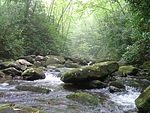 Cherokee Cherokee
Cherokee National Forest has eleven
wilderness areas, three large lakes, and
over 600 mi (970 km) of trails, including
150 mi (240 km) of the Appalachian Trail in
the Great Smoky Mountains. There are 43
mammal species, 154 fish species, 55
amphibian species, and 262 bird species in
the forest. This national forest is also
partially located in the state of Tennessee. |
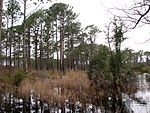 Croatan Croatan
The only coastal National Forest on the east
coast, Croatan includes estuaries and
pocosins. The forest is home to carnivorous
plants such as the Venus flytrap and pitcher
plant. Cedar Point is a recreation area at
the mouth of the White Oak River. |
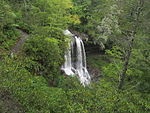 Nantahala Nantahala
In southwestern North Carolina, this forest
includes the Nantahala Gorge and Nantahala
River. There are 600 mi (970 km) of trails
in the forest with elevations ranging from
1,200 ft (370 m) to 5,800 ft (1,800 m) on
Lone Bald. |
 Pisgah Pisgah
Elevations in Pisgah National Forest reach
over 6,000 ft (1,800 m), and there are
46,600 acres (18,900 ha) of old-growth
forests, including 10,000 acres (4,000 ha)
in Linville Gorge. There are three
wilderness areas in the forest: Linville
Gorge, Middle Prong, and Shining Rock. |
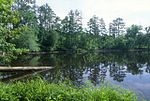 Uwharrie Uwharrie
Uwharrie National Forest borders the eastern
side of Badin Lake and has one wilderness
area: the Birkhead Mountains Wilderness. The
forest is managed together with North
Carolina's other National Forests. |
|
|
|
National Parks |
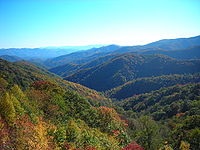 Great
Smoky Mountains Great
Smoky Mountains
The Great Smoky Mountains, part of the
Appalachian Mountains, span a wide range of
elevations, making them home to over 400
vertebrate species, 100 tree species, and
5000 plant species. Hiking is the park's
main attraction, with over 800 miles (1,300
km) of trails, including 70 miles (110 km)
of the Appalachian Trail. Other activities
include fishing, horseback riding, and
touring nearly 80 historic structures. This
national park is also partially located in
the state of Tennessee. |
|
|
Travel America |
|
|
Great Smokies National Park
(Beginner - Listening,
reading)
A video lesson which shows you an interesting place in America.
The English is
spoken at 75% of normal speed.
Great English listening and reading practice.
This video is all about Great Smokies National Park. |
|
 Travel
America Travel
America
Do you love America and American English? Learn before
you travel. Facts and other cool stuff about your
favorite U.S. state. Visit the Fun Easy English Travel
America pages. Read about the beautiful National
Forests, Parks, and Monuments. Great English reading practice. |
 Drive America Drive America
Planning to drive in America? Learn the rules and
regulations. Great English reading practice. |
|